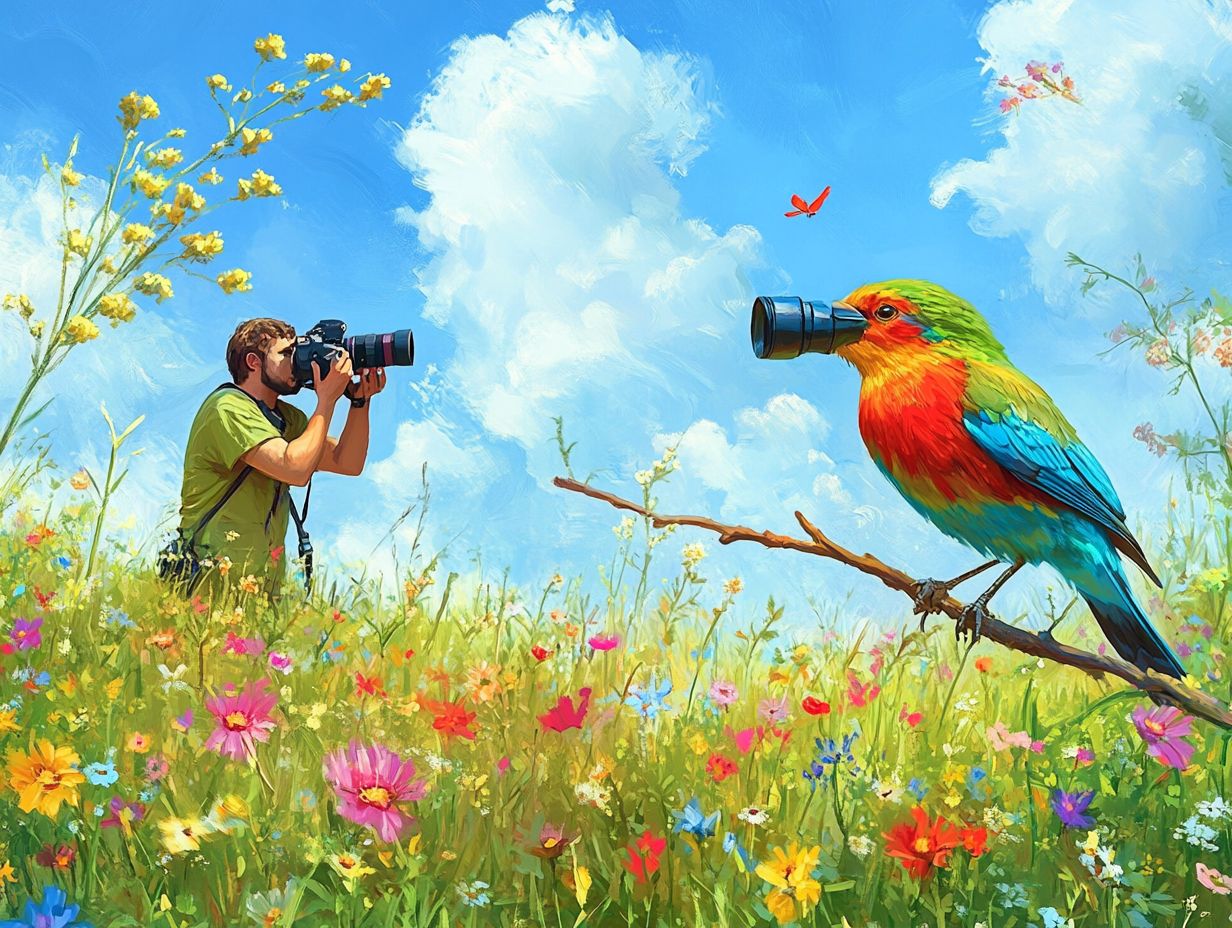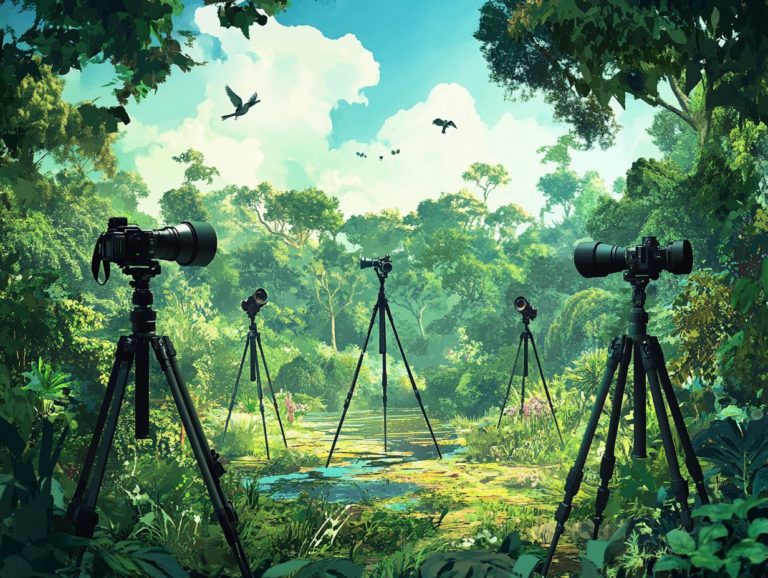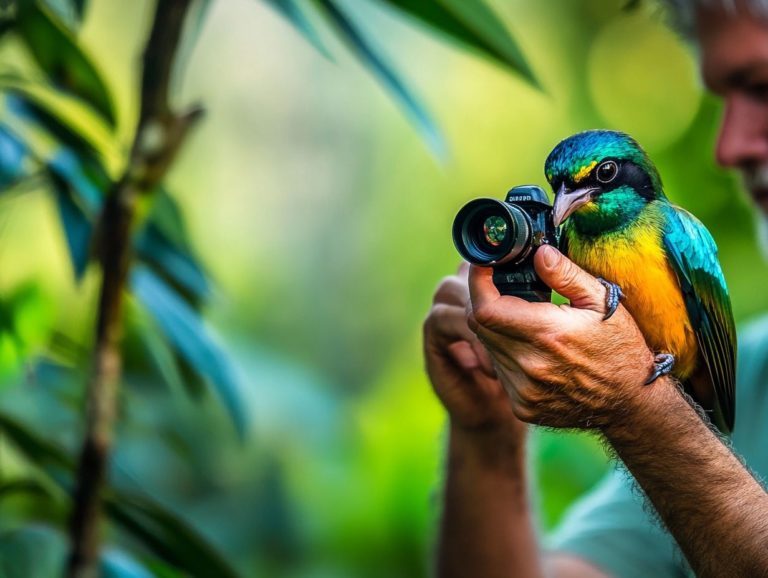Field Notes: Making the Most of Bird Photography
Bird photography is a captivating blend of artistry and nature. It presents a unique glimpse into the avian world.
Whether you re a seasoned photographer or just starting out, capturing stunning images of birds demands the right equipment, techniques, and locations.
Uncover the essential gear you’ll need for breathtaking photos. Learn tips for photographing birds in flight. Discover the best spots to observe these magnificent creatures.
Delve into composition, lighting, and editing techniques that will elevate your bird photography skills. Connect with nature like never before!
Contents
- Key Takeaways:
- What is Bird Photography?
- Equipment for Bird Photography
- Techniques for Capturing Birds in Flight
- Recommended Locations for Bird Photography
- Composition and Lighting in Bird Photography
- Editing and Post-Processing for Bird Photos
- Frequently Asked Questions
- What are field notes and why are they important for bird photography?
- How should I organize my field notes for bird photography?
- What details should I include in my field notes for bird photography?
- Can I share my field notes with other bird photographers?
- How can I use my field notes to improve my bird photography?
- What other benefits do field notes provide for bird photography?
Key Takeaways:
- Invest in good gear for bird photography, including a telephoto lens and a sturdy tripod.
- Master techniques for capturing birds in flight by using a high shutter speed and tracking movements.
- Explore top destinations for bird watching and photography. Pay attention to composition and lighting for stunning results.

What is Bird Photography?
Bird photography is an exciting adventure that lets you capture stunning moments of diverse species in their natural settings. It combines the thrill of birdwatching with the technical aspects of photography.
This journey often requires you to use a digital camera, which captures images electronically. Documenting rare birds and their remarkable behaviors is part of the experience.
Field notes are written observations that help track what you’ve seen. They provide context for each shot, detailing the environmental conditions and identifying features of the birds you encounter, which is especially useful when learning how to photograph migratory birds.
Equipment for Bird Photography
Having the right equipment is crucial for bird photography. It significantly enhances your ability to capture detailed images of elusive species.
Key items in your arsenal should include:
- A high-quality digital camera paired with a suitable lens,
- A sturdy tripod for stability,
- A field notebook for jotting down observations and reminders during your birding adventures.
Essential Gear for Capturing the Best Shots
To capture stunning shots, your essential gear should include not just a high-quality digital camera but also vital equipment like telephoto lenses and sturdy tripods. These items help you capture clear and steady images.
Investing in a quality telephoto lens is pivotal; it allows you to take close-up shots without disturbing the birds. Accessories such as lens filters can enhance image clarity, while a well-constructed backpack helps you organize your gear for easy field access.
Using techniques like audio capture can assist in identifying bird species. Additionally, sketching provides a unique way to document their behavior and habitats. For those interested in enhancing their skills, learning how to capture bird behavior on camera can further enrich both the artistic and observational aspects of your bird photography journey.
Techniques for Capturing Birds in Flight

Capturing birds in flight presents unique challenges that require specific techniques. By mastering your camera s fast shutter speeds and continuous shooting modes, you ll seize exhilarating moments with precision.
Honing your identification skills will greatly enhance your chances of capturing that perfect shot. Additionally, learning how to use composition to enhance bird photos and diligently recording behavioral notes adds to your success in bird photography.
Get out there and start capturing breathtaking bird photos today!
Tips for Getting the Perfect Shot
To achieve the perfect shot in bird photography, you need to consider various factors like composition and lighting. These elements can significantly enhance the outcome of each photograph. Understanding the best times for lighting like the enchanting golden hour and utilizing natural frames can elevate the visual allure of the images you capture in the field.
Framing your subjects within their natural habitats creates a more engaging narrative, drawing viewers into the scene. Don’t hesitate to experiment with different angles; they can reveal unique perspectives. Maintaining a blurred background is also vital, as it helps isolate the bird from distracting backgrounds.
Incorporating techniques like backlighting can add a magical quality to feathers, making them appear almost ethereal. Remember, patience is essential; waiting for that perfect moment often transforms ordinary shots into extraordinary memories.
Recommended Locations for Bird Photography
Identifying the ideal locations for bird photography is essential for enthusiasts aiming to capture a diverse range of avian species, whether in bustling urban settings or tranquil, remote natural environments.
Consider popular destinations that feature local patches celebrated for their rich biodiversity. Renowned birding hotspots draw both rare birds and seasoned photographers looking to elevate their craft.
Top Destinations for Bird Watching and Photography
When it comes to birdwatching and photography, some top destinations offer extraordinary opportunities to observe and capture remarkable species like the Common Gull and Great Northern Diver right in their natural habitats. These places not only boast stunning landscapes but also provide abundant chances to document a variety of bird species throughout the year.
For instance, the coastal regions of Scotland, especially the Isle of Skye, have breathtaking cliffs meeting tranquil waters, attracting a rich array of seabirds, including puffins and eagles. Over in Canada, the wetlands of Point Pelee National Park transform into a vibrant haven during migration seasons, drawing in countless warblers and shorebirds.
You can also explore the expansive wetlands of the Pantanal in Brazil. This area is a treasure trove for exotic species like the Hyacinth Macaw and Jabiru Stork, enhancing both your experience and photographic portfolio.
These destinations promise you incredible bird sightings and immerse you in environments that elevate your appreciation of nature.
Composition and Lighting in Bird Photography

In bird photography, composition and lighting are essential elements that can profoundly impact the quality of your visual documentation.
By mastering the principles of composition, like the rule of thirds, and using natural lighting to amplify colors, you can transform your images of birds into an art form that captures both beauty and emotion.
How to Compose and Capture Stunning Images
To compose and capture stunning images in bird photography, you must employ effective composition techniques that draw the viewer’s eye and highlight the unique characteristics of each bird. Additionally, using tips for photographing rare bird species can further enhance your skills. Keeping detailed field notes documenting the location, behavior, and settings can provide invaluable context that enhances your images’ storytelling.
In particular, you can utilize techniques like framing to create a natural border that elevates your subject against its environment. Use leading lines, whether formed by branches or pathways, to guide the viewer s focus directly to the avian subject, adding dynamic quality to the scene. Employing negative space around the bird can evoke feelings of isolation or tranquility, accentuating the intricate details of your subject.
By referencing comprehensive field notes from previous encounters, you can refine your approach for future outings, allowing you to make more informed choices regarding composition and settings for each unique situation.
Editing and Post-Processing for Bird Photos
Editing and post-processing are essential components in the realm of bird photography, enabling you to elevate your images and weave engaging stories from your captures.
Employing techniques like color correction (which adjusts the colors to look more accurate), cropping, and sharpening can significantly enhance the details. This ensures that your photographs authentically reflect the stunning beauty of the birds and their natural habitats.
Get ready to transform your snapshots into stunning images that will leave your viewers in awe!
Enhancing and Polishing Your Images
Enhancing and polishing your images in bird photography requires a range of editing techniques that elevate the presentation and impact of each photograph. By making adjustments like contrast, saturation, and sharpening, your images will not only document your field experiences but also captivate your viewers.
One effective approach is adjusting the levels to unveil the intricate details in the feathers, adding depth and dimension to your subject. Employing subtle vignetting a darkening effect around the edges of the photo can skillfully direct the viewer s attention toward the bird, enhancing the central composition.
Cropping is another vital technique that can refine your framing, eliminating distractions while preserving the essence of the bird’s environment. It’s crucial to maintain a balance; over-editing can undermine the authenticity of your photograph, making it appear overly processed instead of a genuine capture of nature.
Enhancements can elevate the beauty of your bird photographs, but they should always aim to represent the true essence of the wildlife experience.
Frequently Asked Questions

What are field notes and why are they important for bird photography?
Field notes consist of observations and information collected while taking photographs in the field. They are important for bird photography because they help identify bird species, track behavior, and provide details for future reference. When preparing for a bird photography outing, effective record keeping can greatly improve your understanding of bird observation.
How should I organize my field notes for bird photography?
There is no one right way to organize field notes, but it’s important to have a system that works for you. Some photographers prefer to use a notebook or journal, while others use digital methods like a note-taking app or spreadsheet.
What details should I include in my field notes for bird photography?
Include these details in your field notes for bird photography: date, time, location, weather conditions, bird species observed, behavior observed, and any other relevant information such as habitat or vocalizations. For those new to the hobby, learning how to get started with bird photography can be valuable, as adding detailed descriptions in your notes can also enhance their value.
Yes, sharing field notes with other bird photographers can be beneficial as it allows for collaboration and knowledge sharing. Just be sure to respect the privacy of any sensitive or private information in your notes.
How can I use my field notes to improve my bird photography?
Reviewing your field notes helps you learn about different bird species’ behavior and habits. This knowledge allows you to anticipate their actions and capture stunning photographs, especially if you understand the basics of bird photography composition.
You can also track migration patterns to plan your future photography trips. For instance, using eBird documentation offers valuable insights into bird movements.
What other benefits do field notes provide for bird photography?
Field notes not only improve your photography skills but also provide critical data for scientific research and conservation efforts.
By documenting bird sightings, behaviors, and locations, you contribute valuable information to the birding community. For tips on capturing these moments, check out our guide on how to photograph birds in urban settings. Start using your field notes today and enhance both your photography and the birding community!






